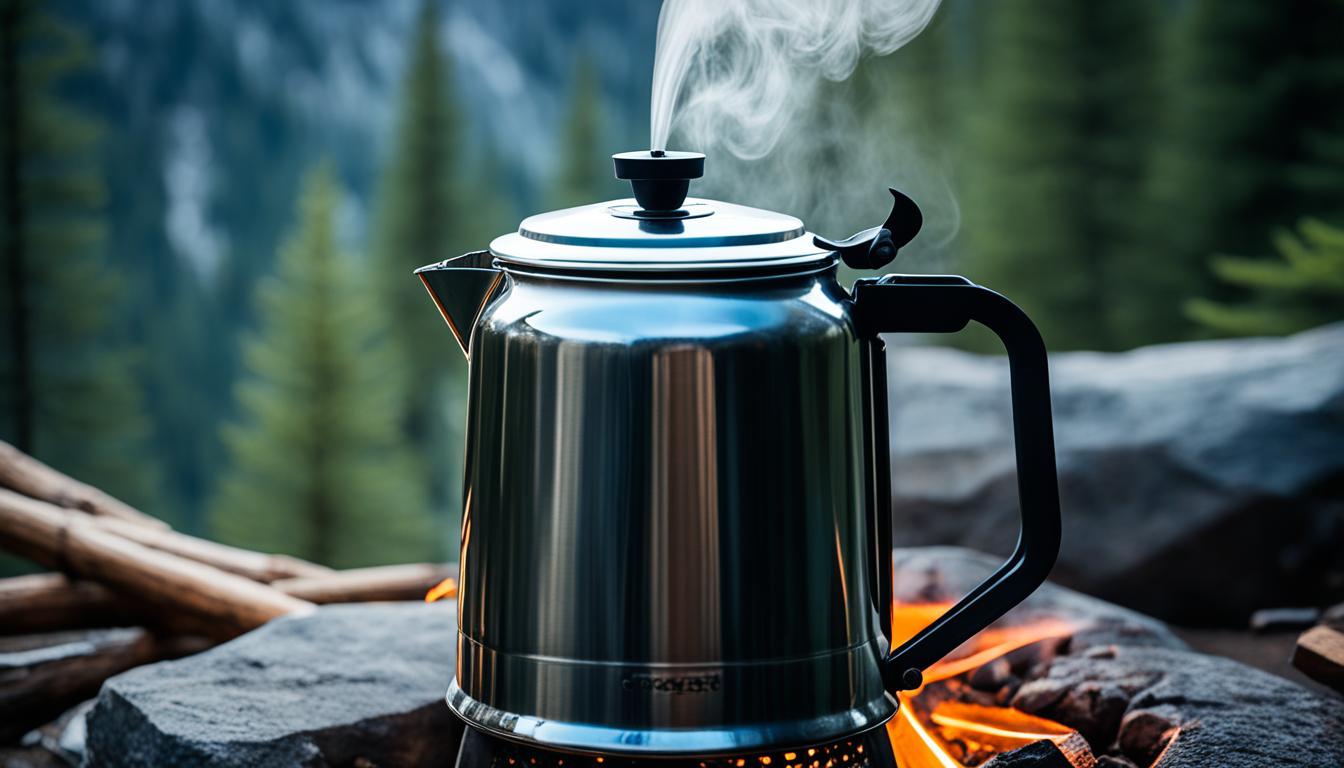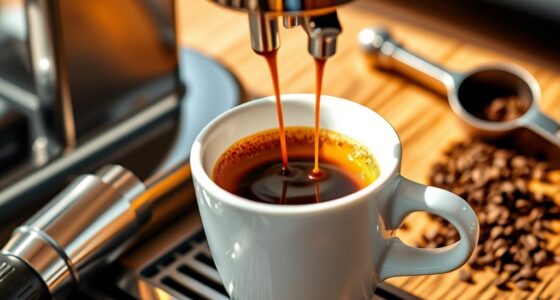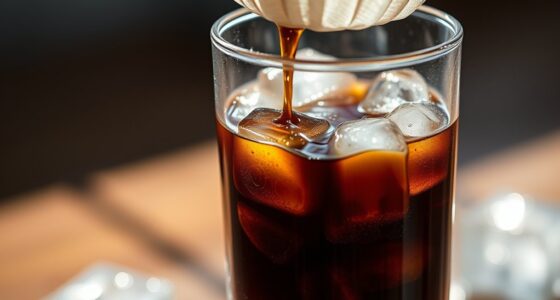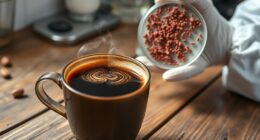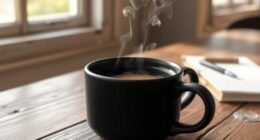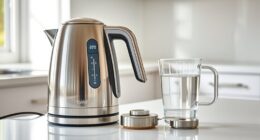Interested in learning how to brew the perfect cup of coffee? It’s easier than you might think. No need for expensive gadgets or complicated techniques. All you really need is a reliable coffee maker and some basic knowledge. Ready to uncover the secrets of using a coffee maker to make great coffee?
Imagine waking up to the aroma of freshly brewed coffee, crafted just the way you like it. No more rushing to the coffee shop or settling for mediocre instant coffee. With a coffee maker at hand, you can have the perfect cup of joe, brewed to perfection, in the comfort of your own home.
In this comprehensive guide, we will walk you through the entire brewing process using a drip coffee maker. From choosing the right equipment to adjusting the brew strength and exploring different coffee types, we’ve got you covered.
So, whether you’re a coffee aficionado looking to improve your brewing skills or a coffee lover who wants to master the art of making coffee at home, this guide is for you. Get ready to unlock the secrets of brewing coffee with a coffee maker and elevate your coffee experience to new heights.
Key Takeaways:
- Using a coffee maker is a convenient and easy way to enjoy a delicious cup of coffee at home.
- With the right steps and techniques, you can brew the perfect cup of coffee every time.
- Choose the right equipment and understand how to adjust the brew strength for optimal results.
- Grinding fresh coffee and experimenting with different coffee types can enhance your coffee experience.
- Cleaning your coffee maker regularly is essential for maintaining the quality of your brew.
The Equipment You Need
To make coffee with a coffee maker, you will need a few essential items. These include:
- A coffee maker: This is the main equipment that will brew your coffee. Choose a reliable and user-friendly coffee maker for the best results.
- A coffee filter: Some coffee makers require a filter to separate the coffee grounds from the brewed coffee. Check the specifications of your coffee maker to determine if a filter is necessary.
- A mug: This is where you will pour and enjoy your freshly brewed coffee. Select a mug that suits your preferred coffee serving size.
- Water: Water is an essential ingredient for brewing coffee. Ensure that you have clean and fresh water available.
- A tablespoon: Use a tablespoon to measure the appropriate amount of ground coffee for your desired coffee strength.
- Your favorite ground coffee: Choose a high-quality ground coffee that matches your taste preferences. Experiment with different brands and flavors to find your perfect cup of coffee.
Having all these items ready before starting the brewing process will ensure a smooth and enjoyable coffee-making experience.
Brewing with a Drip Coffee Maker
The process of brewing coffee with a drip coffee maker is straightforward and convenient. By following these simple steps, you can enjoy a freshly brewed cup of coffee in no time.
Step 1: Add Water to the Reservoir
The first step is to add water to the reservoir of your coffee maker. Make sure to measure the correct amount using the markers on the machine. The reservoir is located at the back or side of the coffee maker, and it’s usually easy to access. Pour the water into the reservoir, ensuring that you add enough for the desired number of cups of coffee.
Step 2: Prepare the Coffee Filter
Next, it’s time to prepare the coffee filter. Place a coffee filter into the basket of the coffee maker. Ensure that the coffee filter fits properly and covers the entirety of the basket. The coffee filter helps to trap the ground coffee, ensuring a smooth and flavorful cup of coffee.
Step 3: Add Ground Coffee to the Filter
Now, add the appropriate amount of medium ground coffee to the coffee filter. The amount of ground coffee needed may vary depending on your personal taste preferences and the strength of the coffee you desire. It is generally recommended to use 1 to 2 tablespoons of ground coffee per 6 fl oz (180 ml) of water. Adjust the amount of coffee accordingly to achieve your preferred taste.
Step 4: Brew Your Coffee
With the water and coffee in place, it’s time to start the brewing process. Power on your coffee maker and wait for it to brew the coffee. The brewing time will vary depending on the coffee maker model and settings. Typically, it takes around 4 to 6 minutes for the brewing process to complete. During this time, the coffee maker heats the water and pours it over the ground coffee, extracting the flavors and oils to create a delicious cup of coffee.
Step 5: Pour and Enjoy
Once the brewing process is complete, carefully remove the carafe or mug from the coffee maker. Pour yourself a cup of the freshly brewed coffee and enjoy it while it’s still hot. Take a moment to savor the aroma and flavor of your homemade coffee. Sit back, relax, and let the rich taste of a perfectly brewed cup of coffee rejuvenate your senses.
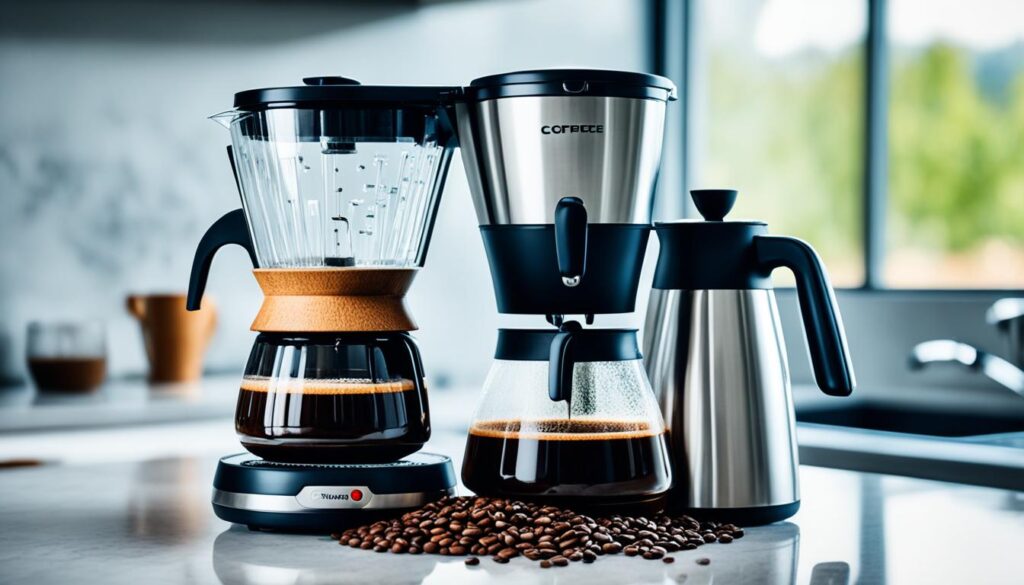
With these simple steps, brewing coffee with a drip coffee maker becomes a breeze. The convenience and efficiency of a coffee maker allow you to enjoy a delicious cup of coffee without the hassle of manual brewing methods. Experiment with different ground coffee varieties and adjust the water-to-coffee ratio to find the perfect balance for your taste buds. So why wait? Start brewing your favorite coffee today using your trusty drip coffee maker!
Tips for Brewing with a Coffee Maker
To ensure the best-tasting coffee, follow these helpful tips when brewing with a coffee maker. Always start with fresh water and use the appropriate amount according to your coffee maker’s instructions. It is recommended to use filtered water for the best taste.
When storing ground coffee, keep it in an airtight container away from sunlight, heat, and moisture to maintain its freshness. Proper storage ensures that the coffee retains its flavor and aroma.
Serve your coffee within 20 minutes of brewing for optimal flavor. If you’re not able to consume it right away, it’s best to transfer it to an insulated container to keep it hot. This prevents the coffee from becoming over-extracted or losing its heat.
Avoid reheating coffee as it can dull the flavor. Instead, brew a fresh cup when you’re ready for another serving. This ensures that you always enjoy the full richness of your coffee.
Why Fresh Water Matters
Using fresh water is crucial for brewing high-quality coffee. Water that has been sitting for too long may contain impurities or stale flavors that can affect the taste of your coffee. By starting with fresh water, you ensure that only clean, pure water comes into contact with your coffee grounds, allowing the natural flavors to shine through.
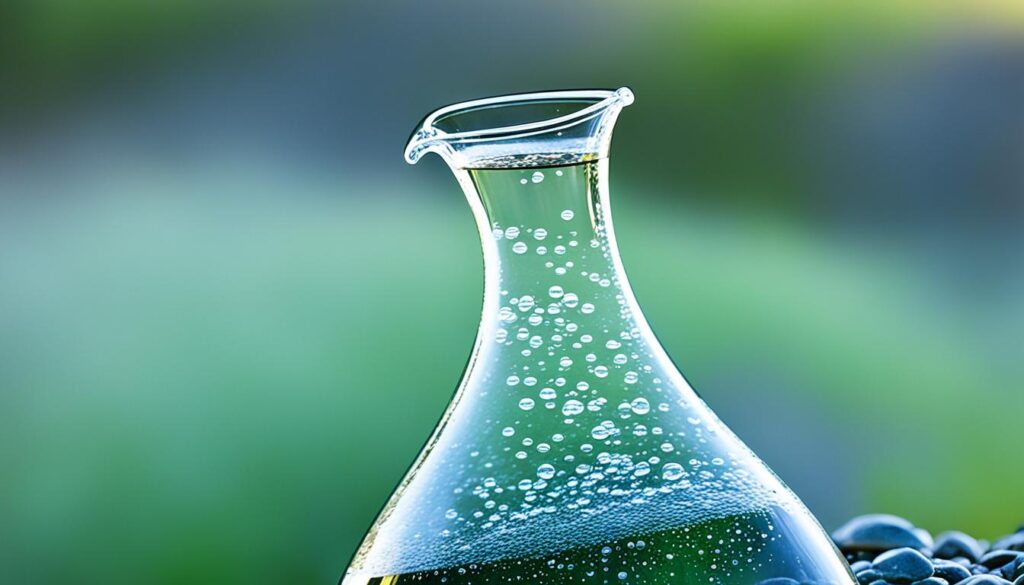
Adjusting the Brew Strength
Different coffee makers can have varying cup sizes, so it’s essential to understand how your specific coffee maker measures a “cup.” If you’re unsure, a simple method to determine the cup size is by measuring and pouring 12 fl oz (350 ml) of water into the reservoir. This will give you an accurate idea of the cup size measurement used by your coffee maker. Adjust the water and coffee measurements accordingly to achieve the desired strength and flavor.
Some coffee makers also feature a strength selector that allows you to customize the brew to your preference. This feature is particularly useful if you enjoy a stronger or milder cup of coffee. However, for most coffee makers, it is generally recommended to use the default setting for the best results.
Adjusting the Water and Coffee Measurements
To adjust the brew strength, you’ll need to modify both the water measurement and the coffee ground measurement. Here’s a simple guide to help you:
| Strength Level | Water | Coffee Grounds |
|---|---|---|
| Regular | Standard cup size according to your coffee maker | 1 tablespoon per cup |
| Strong | Use slightly less water than the standard cup size | 1-2 tablespoons per cup |
| Mild | Use slightly more water than the standard cup size | 3/4 tablespoon per cup |
Keep in mind that these measurements are just guidelines, and you can adjust them further based on your personal preference. Be sure to experiment with different ratios until you find the perfect brew strength for your taste buds.
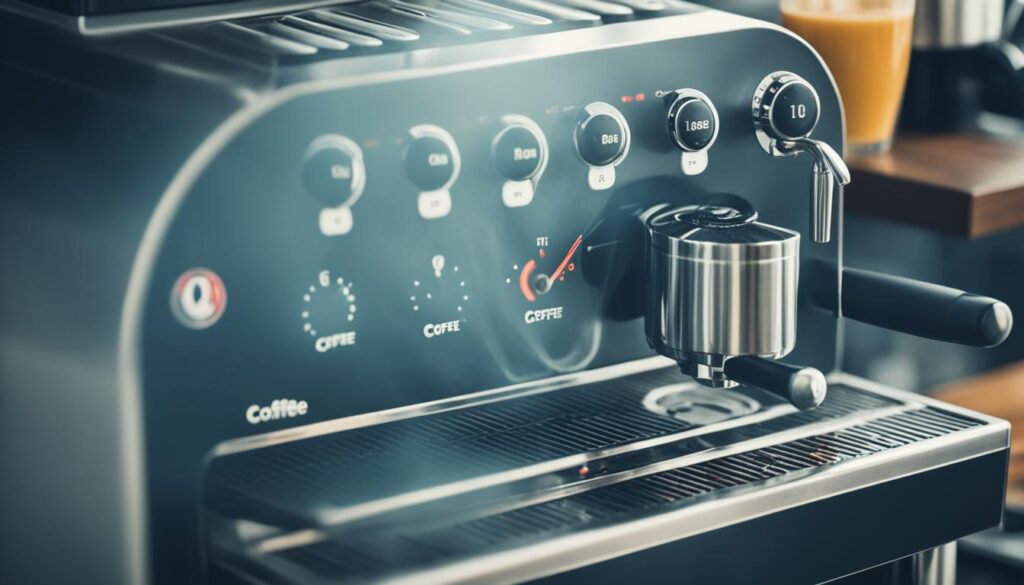
“Finding the ideal brew strength requires a delicate balance between water and coffee measurements. By making slight adjustments to these variables, you can create a cup of coffee that perfectly suits your taste.” – Justin, seasoned author, coffee and tea enthusiast, and an essential member of the Cappuccino Oracle team
Grinding Coffee for Your Coffee Maker
One of the essential steps in brewing a perfect cup of coffee with your coffee maker is grinding the coffee beans to the right size. This process greatly influences the flavor and aroma of your coffee.
For most drip coffee makers, a medium grind size is recommended. It strikes a balance between the coarser grind for French press and the finer grind for espresso. The medium grind allows the water to interact with the coffee grounds sufficiently, extracting the desired flavors without over-extraction.
If you own a coffee grinder, look for a specific “drip” setting. This setting is specifically tailored for drip coffee makers, ensuring that you achieve the optimal grind size. Alternatively, you can grind the coffee beans until most particles resemble the size of sand. This sand-like consistency allows for even extraction and a smooth cup of coffee.
If you prefer the convenience of pre-ground coffee, ensure that it is fresh and of high quality. Freshly ground coffee beans retain more of their flavors, resulting in a more flavorful brew. Look for whole bean coffee from reputable brands or local roasters and grind it just before brewing for the best results.
Remember, proper grinding and using fresh coffee are essential for unlocking the full potential of your coffee maker and enjoying a truly satisfying cup of coffee.

The Impact of Grind Size
The size of the coffee grounds plays a crucial role in the extraction process. Different grind sizes extract flavors at different rates, affecting the taste of your brewed coffee. Here’s a breakdown of how grind size impacts your coffee:
Coarse Grind: Coarse grind is recommended for methods like French press, where the coffee grounds are immersed in water for a longer time. The larger particles result in a slower extraction, producing a rich and bold cup of coffee.
Medium Grind: Medium grind is ideal for drip coffee makers. It allows for a balanced extraction, yielding a well-rounded and flavorful cup of coffee.
Fine Grind: Fine grind is commonly used for espresso machines or Moka pots. The fine particles increase the surface area for extraction, resulting in a concentrated and robust coffee flavor.
By adjusting the grind size based on your brewing method, you can optimize the flavor profile to match your preferences.
Cleaning Your Coffee Maker
Regular cleaning of your coffee maker is essential to maintain the quality of your brew and ensure a great tasting cup of coffee every time. Over time, oils and residue can accumulate, impacting the flavor of your coffee. By following a proper cleaning routine, you can keep your coffee maker in optimal condition and ensure a fresh and flavorful brew.
Refer to the Manual
When it comes to cleaning your coffee maker, it’s always best to consult the manufacturer’s manual for specific instructions. The manual will provide guidance on the recommended cleaning frequency and procedures for your particular coffee maker model. It may include step-by-step instructions, tips, and even cleaning solutions that are safe to use.
Regular Cleaning
To keep your coffee maker clean, start by removing any leftover coffee grounds or filters. Dispose of them properly. Then, use a mild dish soap or a coffee maker cleaning solution recommended by the manufacturer. Dilute the solution with water as instructed. Take care to clean all accessible parts of the coffee maker, such as the water reservoir, filter basket, and carafe.
Regular cleaning of your coffee maker is essential to remove any built-up oils and residue that can affect the taste of your coffee.
Pay special attention to any areas prone to oil or residue buildup, such as the spout, where oils can accumulate and impact the taste of your brewed coffee. Scrub gently using a soft brush or sponge, ensuring that you reach all the nooks and crannies of your coffee maker.
Descale Your Coffee Maker
In addition to regular cleaning, descaling your coffee maker is important to remove mineral deposits that can affect its performance and the taste of your coffee. Mineral buildup can occur over time, especially if you live in an area with hard water. Refer to your coffee maker’s manual for instructions on how to descale it properly using a descaling solution or a homemade vinegar solution.
Maintain the Taste of Your Coffee
Regular cleaning not only helps remove oils and residue but also ensures that your coffee maker continues to produce delicious-tasting coffee. By keeping your coffee maker clean, you can prevent the buildup of stale flavors and maintain the true taste of your coffee beans. It’s recommended to clean your coffee maker at least once a month, but more frequent cleaning might be necessary based on usage and water quality.
Remember, a clean coffee maker not only enhances the taste of your brewed coffee but also prolongs the lifespan and performance of your machine. So, make sure to incorporate regular cleaning into your coffee brewing routine for the best results.
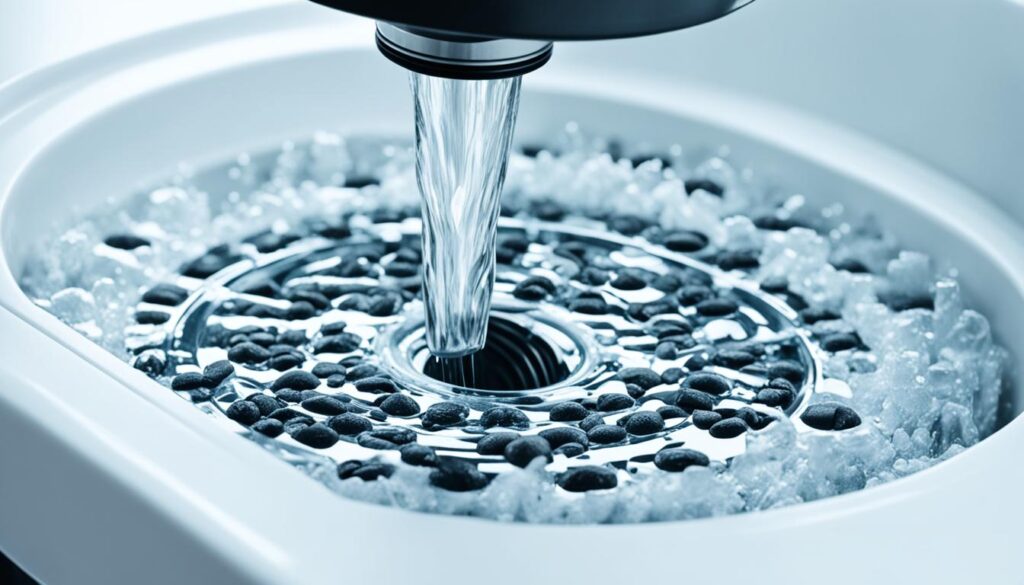
Using Different Coffee Types
Coffee makers are designed to work with various types of coffee, including whole beans and pre-ground coffee. However, for the best results, using freshly ground coffee beans is recommended to maximize flavor and aroma. Experiment with different types and flavors of coffee to find what suits your taste preferences best.
Whole beans are the preferred choice for coffee enthusiasts who value freshness and the ability to customize their grind size. When using whole beans, you have control over the grind, allowing you to adjust the coarseness to match your brewing method and personal preference. Grinding coffee beans just before brewing ensures that the flavors and aromas are at their peak.
Pre-ground coffee, on the other hand, offers convenience and simplicity. It is an excellent option for those who want a quick and hassle-free brewing experience. Pre-ground coffee is available in various grind sizes, catering to different brewing methods such as drip coffee makers.
Whether you choose whole beans or pre-ground coffee, the flavor and aroma of your coffee will depend on factors such as the coffee bean variety, roast level, and brewing technique. Try experimenting with different types of coffee to discover new flavors and aromas that excite your taste buds.
The Difference Between Drip Coffee and Pour-Over Coffee
Drip coffee and pour-over coffee are two different brewing methods that offer unique experiences for coffee enthusiasts. While both methods can produce delicious coffee, they differ in terms of the brewing process and the level of control over various variables.
Drip Coffee
In drip coffee brewing, a coffee maker with automatic brewing functionality is used to heat and dispense water over the coffee grounds. This method is convenient and requires minimal effort, making it a popular choice for many coffee lovers. The machine takes care of tasks such as heating the water to the appropriate temperature and regulating the flow rate.
With drip coffee, you can enjoy the simplicity of automatic brewing. It’s perfect for those who appreciate convenience and want a hands-off approach to making their morning cup of coffee. The automatic brewing process ensures consistency in water temperature, flow rate, and extraction.
Pour-Over Coffee
Pour-over coffee, on the other hand, involves manual pouring of hot water over the coffee grounds in a controlled manner. This method offers a more hands-on and interactive coffee brewing experience.
When making pour-over coffee, you have the freedom to control variables such as water temperature, flow rate, and coffee-to-water ratio. This level of control allows you to create a customized brewing process tailored to your taste preferences. You can experiment with different water temperatures and pours to bring out specific flavor notes in each coffee batch.
Pour-over brewing allows coffee enthusiasts to elevate their coffee experience by having greater control over water temperature and flow rate, resulting in a more nuanced and personalized cup of coffee.
Choosing Between Drip and Pour-Over
The choice between drip coffee and pour-over coffee ultimately depends on personal preference. If you value convenience and consistency, drip coffee brewing with its automatic brewing capabilities might be the ideal choice for you. On the other hand, if you enjoy having control over variables such as water temperature and flow rate to unlock unique flavor profiles, the pour-over method may be more appealing.
Both brewing methods offer their own advantages and can lead to exceptional coffee. Regardless of your choice, the most important factors in brewing a delicious cup of coffee are using high-quality beans and paying attention to the overall brewing process.

Explore the graphic showcasing the process of pouring water over coffee beans for a pour-over brewing method. The image depicts the manual pouring aspect of this brewing technique and reinforces the emphasis on control over water temperature and flow rate to achieve a personalized coffee experience.
Elevate Your Coffee Experience with Trade Coffee
If you’re looking to elevate your at-home coffee brewing routine, consider subscribing to Trade Coffee. With Trade, you can discover a curated selection of specialty coffees from top roasters across the country. Simply visit their website, take a quick quiz to indicate your flavor preferences and brewing equipment, and receive personalized coffee recommendations. Enjoy a world of delicious, freshly-roasted coffees delivered straight to your door.
Trade Coffee offers a convenient coffee subscription service that caters to your specific taste preferences. Whether you enjoy bold and full-bodied flavors or prefer a lighter and more nuanced cup, Trade has a wide range of options to satisfy every coffee lover.
With Trade, you have the opportunity to explore a variety of specialty coffees that you may not find at your local grocery store. Their network of roasters includes renowned names in the industry, ensuring that you’re getting the highest quality beans.
When you sign up for a coffee subscription with Trade, you’ll have the chance to select your preferred brewing method. Whether you use a drip coffee maker, a French press, or a pour-over method, Trade will recommend coffees that are best suited for your chosen brewing technique.
Trade Coffee takes the guesswork out of finding the perfect cup. Their coffee experts curate a selection of beans based on your flavor preferences, ensuring that you’ll always have an exceptional coffee experience. This personalized approach allows you to discover new flavors, expand your coffee palate, and truly savor every sip.
Don’t settle for mediocre coffee. Elevate your morning routine with Trade Coffee and indulge in the rich flavors and aromas of specialty coffees. Start your coffee subscription today and experience the joy of brewing exceptional coffee in the comfort of your own home.
Benefits of Trade Coffee Subscription
| Benefits | Details |
|---|---|
| Curated Specialty Coffees | Discover a selection of specialty coffees from top roasters across the country. |
| Personalized Flavor Preferences | Take a quiz to indicate your flavor preferences and receive personalized coffee recommendations. |
| Options for Every Brewing Method | Select your preferred brewing method and receive coffees best suited for your chosen technique. |
| Exceptional Coffee Experience | Expertly curated beans ensure that you’ll always have a high-quality and flavorful cup of coffee. |
| Expand Your Coffee Palate | Explore new flavors and expand your coffee horizons with an ever-changing selection of coffees. |
Get Started with Trade Coffee
- Visit Trade Coffee’s website.
- Take a quick flavor quiz to indicate your coffee preferences and brewing equipment.
- Choose a subscription plan that suits your needs and frequency of delivery.
- Select your preferred brewing method to receive coffees best suited for your technique.
- Sit back, relax, and await the arrival of your custom-curated specialty coffees.
Trade Coffee has revolutionized my morning routine. Their curated selection of specialty coffees has introduced me to flavors I never knew existed. I look forward to my monthly deliveries and savoring each cup.” – Charles, Trade Coffee subscriber & Strategic Editor in Chief

Conclusion
Making coffee with a coffee maker is a simple and enjoyable process. By following the steps outlined in this guide and implementing the tips from reputable sources like Starbucks, you can brew the perfect cup of coffee at home. Experiment with different coffee types, grind sizes, and brewing techniques to find the flavor profile that suits your taste preferences. For a more rustic and adventurous brewing experience, consider using a campfire coffee percolator. This method can add a special flavor to your coffee that can’t be achieved with a traditional coffee maker. By taking the time to explore different brewing methods, you can uncover a whole new world of delicious and unique coffee flavors. Whether you prefer the convenience of a modern coffee maker or the nostalgia of a campfire coffee percolator, there’s a method out there to suit everyone’s taste.
With practice and attention to detail, you can become a master of coffee brewing with a coffee maker. Whether you prefer a strong and bold brew or a smooth and aromatic cup, the possibilities are endless. Enjoy the satisfaction of creating your favorite coffee beverages right in your own kitchen.
Now that you have the knowledge and tools, it’s time to embark on your coffee brewing journey. Remember, each cup is an opportunity to explore and refine your skills. So grab your coffee maker, choose your favorite coffee, and start brewing the perfect cup of joe for yourself and your loved ones. Cheers!


